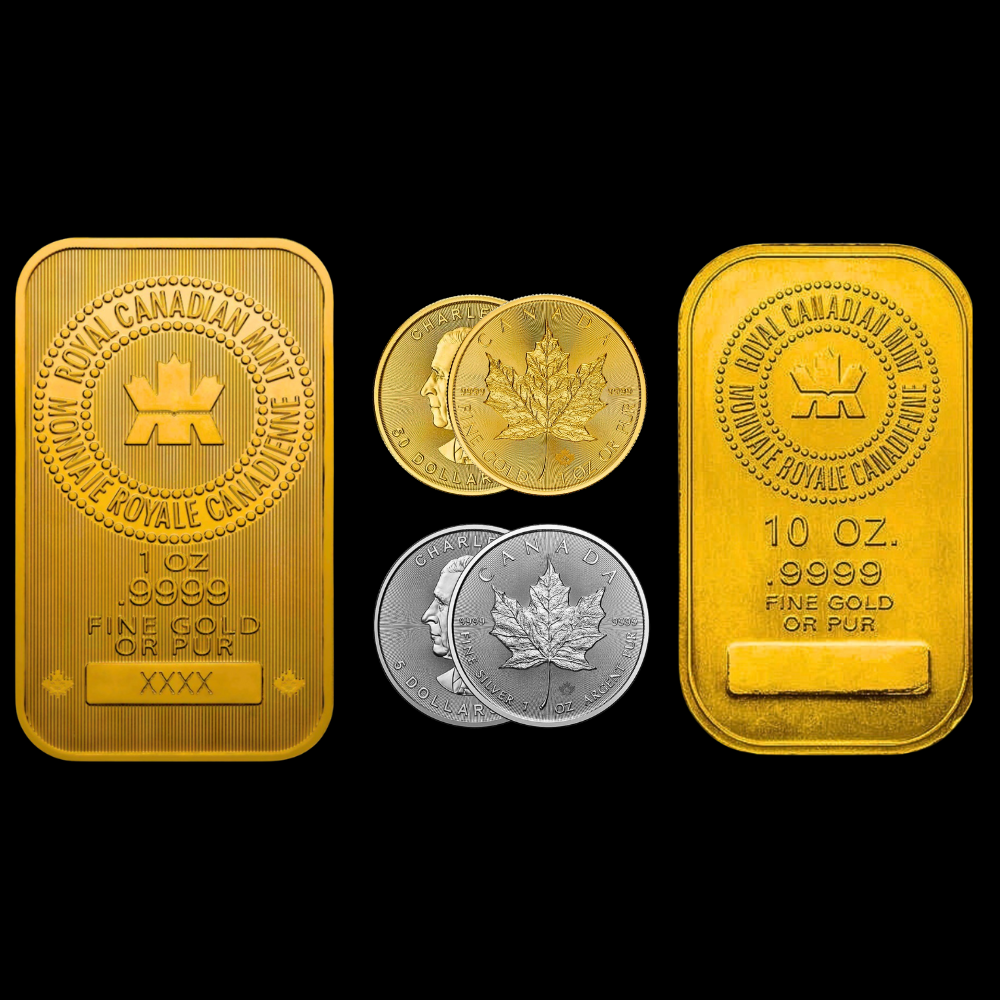
Canadian Maple Leaf Collection: Royal Canadian Mint Excellence
The Maple Leaf collection, minted by the Royal Canadian Mint, melds classic artistry with contemporary minting quality, offering valuable and dependable pieces that represent Canada's numismatic heritage.
Gold Deals
-
1/10oz Canadian Maple Leaf Gold Coin (2024)
Vendor:Royal Canadian MintRegular price As Low As
$447.40 CADRegular priceSale price As Low AsUnit price / per
$447.40 CADSale -
1/4 oz Canadian Maple Leaf Gold Coin (2024)
Vendor:Royal Canadian MintRegular price As Low As
$1,074.15 CADRegular priceSale price As Low AsUnit price / per
$1,074.15 CADSale -
1oz Royal Canadian Mint Gold Bar
Vendor:Royal Canadian MintRegular price As Low As
$3,934.16 CADRegular priceSale price As Low AsUnit price / per
$3,934.16 CADSale -
1oz Valcambi Gold Bar
Vendor:Valcambi MintRegular price As Low As
$3,902.06 CADRegular priceSale price As Low AsUnit price / per
$3,902.06 CADSale -
1/2oz Australian Kangaroo Gold Coin (2024)
Vendor:Perth MintRegular price As Low As
$2,053.91 CADRegular priceSale price As Low AsUnit price / per
$2,053.91 CADSale -
1/2oz Austrian Philharmonic Gold Coin (2024)
Vendor:Austrian MintRegular price As Low As
$2,065.24 CADRegular priceSale price As Low AsUnit price / per
$2,065.24 CADSale
Silver Deals
-
1oz Canadian Maple Leaf Silver Coin (2024)
Vendor:Royal Canadian MintRegular price As Low As
$54.03 CADRegular priceSale price As Low AsUnit price / per
$54.03 CADSale -
1oz SilverTowne Saint-Gaudens Silver Round
Vendor:SilverTowne MintRegular price As Low As
$50.96 CADRegular priceSale price As Low AsUnit price / per
$50.96 CADSale -
1oz American Eagle Silver Coin (2024)
Vendor:US MintRegular price As Low As
$56.35 CADRegular priceSale price As Low AsUnit price / per
$56.35 CADSale -
1oz Britannia Silver Coin (2024)
Vendor:The Royal MintRegular price As Low As
$53.95 CADRegular priceSale price As Low AsUnit price / per
$53.95 CADSale -
10oz Britannia Silver Bar
Vendor:The Royal MintRegular price As Low As
$540.22 CADRegular priceSale price As Low AsUnit price / per
$540.22 CADSale
Simplified Investing: Key Insights for Precious Metals
-
Private vs Government Mint
Learn the pros and cons of different sources for your metals. Government mints offer widely recognized coins, while private mints might present cost-effective options with unique designs.
-
Understanding Premiums
Beyond the spot price of metal, premiums cover minting, distribution, and dealer markup. We'll help you understand how to spot fair premiums to ensure you're investing wisely.
-
Choosing Your Metals
From collectible coins to bullion bars, choosing the right form of metal depends on your investment goals. We provide insights into liquidity, resale value, and how to balance your portfolio.
-
Investment Size
How much should you invest in precious metals? We offer guidelines based on your financial goals and risk tolerance, ensuring your investments align with your broader financial strategy.
Why Choose Bullion for Lower Premiums?
Precious metals like gold and silver have been revered throughout history not just for their beauty, but for their role in preserving wealth across generations. They offer a hedge against inflation, serve as a safe haven in times of economic uncertainty, and provide a diversification option that can mitigate risk in your investment portfolio.

Inflation Hedge
As currencies fluctuate, precious metals historically retain value. Their supply is finite, making them a robust store of wealth as the cost of living increases.

Wealth Preservation
From ancient empires to modern markets, precious metals have demonstrated remarkable resilience and growth. An ounce of gold could purchase a fine suit in Roman times, just as it can today.
Portfolio Diversification
Adding precious metals to your investment mix can reduce volatility. Unlike stocks and bonds, they typically move independently of financial markets, offering a buffer during downturns.






